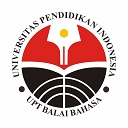The Acquisition of Japanese Case Particles by Indonesian Learners of Japanese: Focusing on the Concept of Kou “Argument” of Verb
Abstract
Keywords
Full Text:
PDFReferences
Iori, I. (2012). Atarashii nihongo-gaku Nyuumon: Kotoba no Shikumi o Kangaeru [A new introduction to Japanese language: Thinking About The Structure of Language]. Tokyo: 3A Network.
Kellerman, E. (1985). If at first you do succeed… In S. Gass & C. Madden (Eds.), Input in Second Language acquisition (pp. 345–353).
Koyanagi, K. (2004). Nihongo Kyoushi no Tame no Atarashii Gengo Shuutoku Gairon [A New Introduction to Language Acquisition for Japanese Language Teachers]. Tokyo: 3A Network.
Long, M. H. (1988). Instructed interlanguage development in L. Beebe (ed.). Issues in Second Language Acquisition: Multiple Perspectives.
Long, M. H. (2000). Focus on form in task-based language teaching. Language policy and pedagogy: Essays in honor of A. Ronald Walton, 179-192.
Long, M. H., & Robinson, P. (1998). Focus on Form: Theory, Research, and Practice. Focus on form in classroom second language acquisition, 2, 15-41.
Maarif, S. (2021). Study on Acquisition of Japanese Adnominal Clauses Using Metalanguage Awareness in Indonesian Learners. JAPANEDU: Jurnal Pendidikan dan Pengajaran Bahasa Jepang, 6(2), 89-97. https://doi.org/10.17509/japanedu.v6i2.36622
Oka, T. (2005). Basho-teki sonzai-ron ni yoru kakujoshi ni no touitsu-teki setsumei [A unified explanation of the case particle ni using locative ontology]. Nihon Ninchi Gengogakkai Ronbun-Shuu, 5, pp. 12-22.
Oka, T. (2007). Nihongo kyouiku e no ninchi gengo-gaku no ouyou: Tagi-go, tokuni kakujoshi [Application of cognitive linguistics to Japanese language education: Polysemous words, especially case particles]. Tokyo Gakugei Daigaku Kiyou, 58, 467-481.
Shimada, M., & Noguchi, H. (2017). Nihongo kyōiku no tame no hajimete no tōkei bunseki [The first statistical analysis for Japanese language education]. Tokyo: Hitsuji Shobo.
DOI: https://doi.org/10.17509/japanedu.v8i2.62701
Refbacks
- There are currently no refbacks.
Copyright (c) 2023 JAPANEDU: Jurnal Pendidikan dan Pengajaran Bahasa Jepang

This work is licensed under a Creative Commons Attribution-ShareAlike 4.0 International License.
 Published by:
Published by: Department of Japanese Language Education, Faculty of Language and Literature Education
Universitas Pendidikan Indonesia
 Online ISSN: Online ISSN:2528-5548 |

JAPANEDU: Jurnal Pendidikan dan Pengajaran Bahasa Jepang (e-ISSN:2528-5548) lisenced under a Creative Commons Attribution-ShareAlike 4.0 Internasional (CC BY-SA 4.0)


